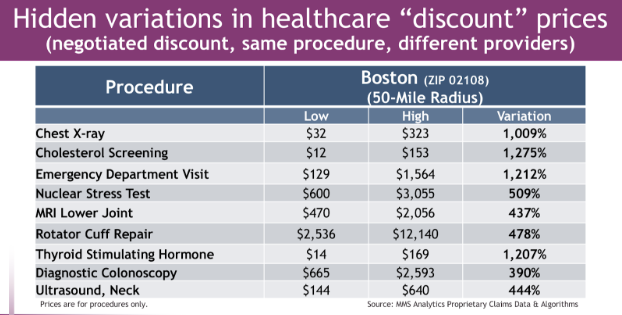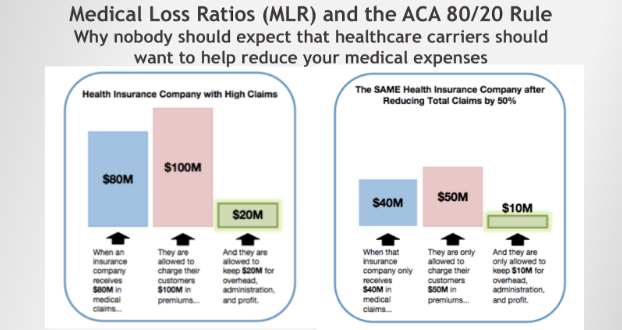In almost every industry in the U.S., consumers can easily access price information to shop. There is one glaring exception to this rule: goods and services in our nation’s healthcare system. Why do we accept the concept that it’s OK that we have no idea what the costs will be until after we have received the service?
As a result, there is no price elasticity that would normally reward vendors who don’t overcharge and reward innovators that reduce costs while improving quality. Because the market for healthcare is broken, disparate prices bear no relationship to cost and quality. Table 1 shows very common examples of how the same medical procedure can have wild price variations within short distances.

Many believe there’s no fix without healthcare price legislation, and recently we have seen some regulations passed and additional measures discussed by our political leaders. But Americans already get consumer-based pricing models in nearly every other industry, and shopping comes naturally to most of us.
See also: Is Transparency the Answer in Healthcare?
So why would anyone wait for the passage of special price transparency regulations before requiring their medical suppliers to support a normal shopping experience?
According to the Peterson Center on Healthcare, U.S. residents paid over $352 billion in out-of-pocket healthcare costs—along with another $3 trillion in healthcare premiums and taxes—to pay for commercial and government healthcare programs last year. This represents a staggering 10x, or 1,000% more than, what parents paid when baby boomers were teenagers. Unlike in the mid-‘70s, most medical tests and procedures vary in cost by 5–10x within a short distance of home, but very few of us recognize this. When we consider we’re just as likely to get the best care at the lowest-cost facility, you might think that we’d all take a personal interest in how we choose the providers and locations we use to receive “shoppable” medical tests and procedures. Yet most of us don’t.
The reason is that the continuing rhetoric among suppliers, legislators and payers—created by the combination of the quasi-regulated environment of healthcare with a third-party, indirect, payer system—interferes with normal market dynamics.
Most legislation aiming to mandate some sort of price transparency has simply provided plausible excuses for the industry to say “we use industry best practices” and “we complied.” This provides cover so the industry isn't subjected to the same consumer protection laws that affect goods and services in every other market. What’s actually needed is less regulatory meddling and more free market principles to reward innovations that lead to higher-quality care at lower costs.

Rhetoric around “personal mandates,” “lifetime caps,” “pre-existing conditions,” “market stabilization,” “Cadillac tax” and other things that relate only to who will pay for healthcare coverage create a smokescreen that ensures that we never talk about the most basic issue in delivering services to this mass-market – price of medical procedures.
Unfortunately, severe unintended consequences were created when many of our state legislators created a set of rules known as Medical Loss Ratio (MLR) rules, and, more recently, these rules have been codified in federal law known as the 80/20 rule. The intended effect was to limit the amount a healthcare carrier could charge a customer in insurance premiums to no more than the actual medical charges plus a fixed percentage to operate the business and provide a reasonable return to shareholders. This type of rule or contract is often referred to as “cost plus.”
The unintended consequence is that carriers have no incentive to reduce medical claims, and therefore premiums and out-of-pocket expenses. Regardless of the carrier’s wish to help you, as long as there are MLR rules (a.k.a. 80/20, "cost plus"), carriers have a financial disincentive that makes them likely unable to survive if the amount of spending on medical procedures and drugs dropped substantially.
Because research has shown that medical price transparency alone (shopping) could knock more than 50% out of healthcare expense, you can see why some might want to slow the movement to consumerism by continuing to maintain secrecy on procedure prices, while beating the drums of healthcare rhetoric. This approach will keep us ignorant of the root cause of the outrageous cost of care in the U.S. – overpaying for medical procedures.
See also: The Search For True Healthcare Transparency
The good news is that more and more individuals have high-deductible health insurance plans, with roughly 36% of all people under the age of 65 currently enrolled in an HDHP. Now there’s a grassroots movement, debunking lies and empowering patients and employers—not lobbyists—to take action.
Intuitive decision support tools continue to be adopted by those who want to be able to compare their options for healthcare based on price, in addition to quality and convenience. Eventually, as price-elasticity is restored to our broken healthcare market, we will see a full reversal of the unsustainable cost trends we’ve experienced over the last decade.
 Many believe there’s no fix without healthcare price legislation, and recently we have seen some regulations passed and additional measures discussed by our political leaders. But Americans already get consumer-based pricing models in nearly every other industry, and shopping comes naturally to most of us.
See also: Is Transparency the Answer in Healthcare?
So why would anyone wait for the passage of special price transparency regulations before requiring their medical suppliers to support a normal shopping experience?
According to the Peterson Center on Healthcare, U.S. residents paid over $352 billion in out-of-pocket healthcare costs—along with another $3 trillion in healthcare premiums and taxes—to pay for commercial and government healthcare programs last year. This represents a staggering 10x, or 1,000% more than, what parents paid when baby boomers were teenagers. Unlike in the mid-‘70s, most medical tests and procedures vary in cost by 5–10x within a short distance of home, but very few of us recognize this. When we consider we’re just as likely to get the best care at the lowest-cost facility, you might think that we’d all take a personal interest in how we choose the providers and locations we use to receive “shoppable” medical tests and procedures. Yet most of us don’t.
The reason is that the continuing rhetoric among suppliers, legislators and payers—created by the combination of the quasi-regulated environment of healthcare with a third-party, indirect, payer system—interferes with normal market dynamics.
Most legislation aiming to mandate some sort of price transparency has simply provided plausible excuses for the industry to say “we use industry best practices” and “we complied.” This provides cover so the industry isn't subjected to the same consumer protection laws that affect goods and services in every other market. What’s actually needed is less regulatory meddling and more free market principles to reward innovations that lead to higher-quality care at lower costs.
Many believe there’s no fix without healthcare price legislation, and recently we have seen some regulations passed and additional measures discussed by our political leaders. But Americans already get consumer-based pricing models in nearly every other industry, and shopping comes naturally to most of us.
See also: Is Transparency the Answer in Healthcare?
So why would anyone wait for the passage of special price transparency regulations before requiring their medical suppliers to support a normal shopping experience?
According to the Peterson Center on Healthcare, U.S. residents paid over $352 billion in out-of-pocket healthcare costs—along with another $3 trillion in healthcare premiums and taxes—to pay for commercial and government healthcare programs last year. This represents a staggering 10x, or 1,000% more than, what parents paid when baby boomers were teenagers. Unlike in the mid-‘70s, most medical tests and procedures vary in cost by 5–10x within a short distance of home, but very few of us recognize this. When we consider we’re just as likely to get the best care at the lowest-cost facility, you might think that we’d all take a personal interest in how we choose the providers and locations we use to receive “shoppable” medical tests and procedures. Yet most of us don’t.
The reason is that the continuing rhetoric among suppliers, legislators and payers—created by the combination of the quasi-regulated environment of healthcare with a third-party, indirect, payer system—interferes with normal market dynamics.
Most legislation aiming to mandate some sort of price transparency has simply provided plausible excuses for the industry to say “we use industry best practices” and “we complied.” This provides cover so the industry isn't subjected to the same consumer protection laws that affect goods and services in every other market. What’s actually needed is less regulatory meddling and more free market principles to reward innovations that lead to higher-quality care at lower costs.
 Rhetoric around “personal mandates,” “lifetime caps,” “pre-existing conditions,” “market stabilization,” “Cadillac tax” and other things that relate only to who will pay for healthcare coverage create a smokescreen that ensures that we never talk about the most basic issue in delivering services to this mass-market – price of medical procedures.
Unfortunately, severe unintended consequences were created when many of our state legislators created a set of rules known as Medical Loss Ratio (MLR) rules, and, more recently, these rules have been codified in federal law known as the 80/20 rule. The intended effect was to limit the amount a healthcare carrier could charge a customer in insurance premiums to no more than the actual medical charges plus a fixed percentage to operate the business and provide a reasonable return to shareholders. This type of rule or contract is often referred to as “cost plus.”
The unintended consequence is that carriers have no incentive to reduce medical claims, and therefore premiums and out-of-pocket expenses. Regardless of the carrier’s wish to help you, as long as there are MLR rules (a.k.a. 80/20, "cost plus"), carriers have a financial disincentive that makes them likely unable to survive if the amount of spending on medical procedures and drugs dropped substantially.
Because research has shown that medical price transparency alone (shopping) could knock more than 50% out of healthcare expense, you can see why some might want to slow the movement to consumerism by continuing to maintain secrecy on procedure prices, while beating the drums of healthcare rhetoric. This approach will keep us ignorant of the root cause of the outrageous cost of care in the U.S. – overpaying for medical procedures.
See also: The Search For True Healthcare Transparency
The good news is that more and more individuals have high-deductible health insurance plans, with roughly 36% of all people under the age of 65 currently enrolled in an HDHP. Now there’s a grassroots movement, debunking lies and empowering patients and employers—not lobbyists—to take action.
Intuitive decision support tools continue to be adopted by those who want to be able to compare their options for healthcare based on price, in addition to quality and convenience. Eventually, as price-elasticity is restored to our broken healthcare market, we will see a full reversal of the unsustainable cost trends we’ve experienced over the last decade.
Rhetoric around “personal mandates,” “lifetime caps,” “pre-existing conditions,” “market stabilization,” “Cadillac tax” and other things that relate only to who will pay for healthcare coverage create a smokescreen that ensures that we never talk about the most basic issue in delivering services to this mass-market – price of medical procedures.
Unfortunately, severe unintended consequences were created when many of our state legislators created a set of rules known as Medical Loss Ratio (MLR) rules, and, more recently, these rules have been codified in federal law known as the 80/20 rule. The intended effect was to limit the amount a healthcare carrier could charge a customer in insurance premiums to no more than the actual medical charges plus a fixed percentage to operate the business and provide a reasonable return to shareholders. This type of rule or contract is often referred to as “cost plus.”
The unintended consequence is that carriers have no incentive to reduce medical claims, and therefore premiums and out-of-pocket expenses. Regardless of the carrier’s wish to help you, as long as there are MLR rules (a.k.a. 80/20, "cost plus"), carriers have a financial disincentive that makes them likely unable to survive if the amount of spending on medical procedures and drugs dropped substantially.
Because research has shown that medical price transparency alone (shopping) could knock more than 50% out of healthcare expense, you can see why some might want to slow the movement to consumerism by continuing to maintain secrecy on procedure prices, while beating the drums of healthcare rhetoric. This approach will keep us ignorant of the root cause of the outrageous cost of care in the U.S. – overpaying for medical procedures.
See also: The Search For True Healthcare Transparency
The good news is that more and more individuals have high-deductible health insurance plans, with roughly 36% of all people under the age of 65 currently enrolled in an HDHP. Now there’s a grassroots movement, debunking lies and empowering patients and employers—not lobbyists—to take action.
Intuitive decision support tools continue to be adopted by those who want to be able to compare their options for healthcare based on price, in addition to quality and convenience. Eventually, as price-elasticity is restored to our broken healthcare market, we will see a full reversal of the unsustainable cost trends we’ve experienced over the last decade.





